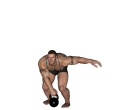 Kettlebell - One Arm Swings
Kettlebell - One Arm Swings
Benefits: This exercise isolates the lateral delt muscle.
Purpose: This exercise strengthens the side deltoid muscle area.
Intermediate Lateral Delts Anterior Delts Posterior Delts Upper Traps Hamstrings Strength Kettlebell Gym
General Info: The deltoid is a fan-shaped muscle group of 3 heads. The anterior (front) delt raises the arm towards the front and rotates the arm inward. The lateral (side) delt raises the arm to the side. The posterior (rear) delt raises the arm toward the rear and rotates the arm outward.
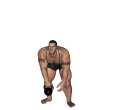 Kettlebell - Pass Between The Legs
Kettlebell - Pass Between The Legs
Benefits: This exercise isolates the lateral delt muscle.
Purpose: This exercise strengthens the side deltoid muscle area.
Intermediate Lateral Delts Anterior Delts Posterior Delts Upper Traps Hamstrings Strength Kettlebell Gym
General Info: The deltoid is a fan-shaped muscle group of 3 heads. The anterior (front) delt raises the arm towards the front and rotates the arm inward. The lateral (side) delt raises the arm to the side. The posterior (rear) delt raises the arm toward the rear and rotates the arm outward.
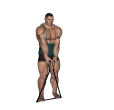 Lateral Raise - Band
Lateral Raise - Band
Benefits: This exercise isolates the lateral delt muscle.
Purpose: This exercise strengthens the side deltoid muscle area.
Beginner Lateral Delts Anterior Delts Posterior Delts Upper Traps Strength Band Pull Gym
General Info: The deltoid is a fan-shaped muscle group of 3 heads. The anterior (front) delt raises the arm towards the front and rotates the arm inward. The lateral (side) delt raises the arm to the side. The posterior (rear) delt raises the arm toward the rear and rotates the arm outward.
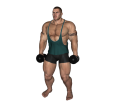 Lateral Raise - Basic
Lateral Raise - Basic
Benefits: This exercise isolates the lateral delt muscle.
Purpose: This exercise strengthens the side deltoid muscle area.
Beginner Lateral Delts Anterior Delts Posterior Delts Upper Traps Strength Dumbbell Pull Gym
General Info: The deltoid is a fan-shaped muscle group of 3 heads. The anterior (front) delt raises the arm towards the front and rotates the arm inward. The lateral (side) delt raises the arm to the side. The posterior (rear) delt raises the arm toward the rear and rotates the arm outward.
 Lateral Raise - Basic Water Bottle
Lateral Raise - Basic Water Bottle
Benefits: This exercise isolates the lateral delt muscle.
Purpose: This exercise strengthens the side deltoid muscle area.
Beginner Lateral Delts Anterior Delts Posterior Delts Upper Traps Strength Water Bottle Pull Home
General Info: The deltoid is a fan-shaped muscle group of 3 heads. The anterior (front) delt raises the arm towards the front and rotates the arm inward. The lateral (side) delt raises the arm to the side. The posterior (rear) delt raises the arm toward the rear and rotates the arm outward.
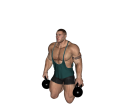 Lateral Raise - Kneeling
Lateral Raise - Kneeling
Benefits: This exercise isolates the lateral delt muscle.
Purpose: This exercise strengthens the side deltoid muscle area.
Beginner Lateral Delts Anterior Delts Posterior Delts Upper Traps Strength Dumbbell Pull Gym
General Info: The deltoid is a fan-shaped muscle group of 3 heads. The anterior (front) delt raises the arm towards the front and rotates the arm inward. The lateral (side) delt raises the arm to the side. The posterior (rear) delt raises the arm toward the rear and rotates the arm outward.
 Lateral Raise - Kneeling Water Bottle
Lateral Raise - Kneeling Water Bottle
Benefits: This exercise isolates the lateral delt muscle.
Purpose: This exercise strengthens the side deltoid muscle area.
Beginner Lateral Delts Anterior Delts Posterior Delts Upper Traps Strength Water Bottle Pull Home
General Info: The deltoid is a fan-shaped muscle group of 3 heads. The anterior (front) delt raises the arm towards the front and rotates the arm inward. The lateral (side) delt raises the arm to the side. The posterior (rear) delt raises the arm toward the rear and rotates the arm outward.
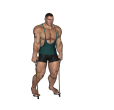 Lateral Raise - Resistance Tube
Lateral Raise - Resistance Tube
Benefits: This exercise isolates the lateral delt muscle.
Purpose: This exercise strengthens the side deltoid muscle area.
Beginner Lateral Delts Anterior Delts Posterior Delts Upper Traps Strength Resistance Tube Pull Gym
General Info: The deltoid is a fan-shaped muscle group of 3 heads. The anterior (front) delt raises the arm towards the front and rotates the arm inward. The lateral (side) delt raises the arm to the side. The posterior (rear) delt raises the arm toward the rear and rotates the arm outward.
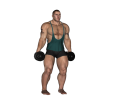 Lateral Raise - Standing
Lateral Raise - Standing
Benefits: This exercise isolates the lateral delt muscle.
Purpose: This exercise strengthens the side deltoid muscle area.
Beginner Lateral Delts Anterior Delts Posterior Delts Upper Traps Strength Dumbbell Pull Gym
General Info: The deltoid is a fan-shaped muscle group of 3 heads. The anterior (front) delt raises the arm towards the front and rotates the arm inward. The lateral (side) delt raises the arm to the side. The posterior (rear) delt raises the arm toward the rear and rotates the arm outward.
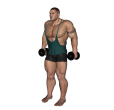 Lateral Raise - Standing Alternate
Lateral Raise - Standing Alternate
Benefits: This exercise isolates the lateral delt muscle.
Purpose: This exercise strengthens the side deltoid muscle area.
Beginner Lateral Delts Anterior Delts Posterior Delts Upper Traps Strength Dumbbell Pull Gym
General Info: The deltoid is a fan-shaped muscle group of 3 heads. The anterior (front) delt raises the arm towards the front and rotates the arm inward. The lateral (side) delt raises the arm to the side. The posterior (rear) delt raises the arm toward the rear and rotates the arm outward.
 Lateral Raise - Standing Water Bottle
Lateral Raise - Standing Water Bottle
Benefits: This exercise isolates the lateral delt muscle.
Purpose: This exercise strengthens the side deltoid muscle area.
Beginner Lateral Delts Anterior Delts Posterior Delts Upper Traps Strength Water Bottle Pull Home
General Info: The deltoid is a fan-shaped muscle group of 3 heads. The anterior (front) delt raises the arm towards the front and rotates the arm inward. The lateral (side) delt raises the arm to the side. The posterior (rear) delt raises the arm toward the rear and rotates the arm outward.
 Lateral Raise - Standing Water Bottle Alternate
Lateral Raise - Standing Water Bottle Alternate
Benefits: This exercise isolates the lateral delt muscle.
Purpose: This exercise strengthens the side deltoid muscle area.
Beginner Lateral Delts Anterior Delts Posterior Delts Upper Traps Strength Water Bottle Pull Home
General Info: The deltoid is a fan-shaped muscle group of 3 heads. The anterior (front) delt raises the arm towards the front and rotates the arm inward. The lateral (side) delt raises the arm to the side. The posterior (rear) delt raises the arm toward the rear and rotates the arm outward.
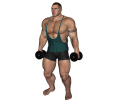 Raise - Dumbbell
Raise - Dumbbell
Benefits: Exercising the traps will provide a thicker, larger and more powerful back development which will help in other exercises and minimize injuries.
Purpose: This exercise develops the trapezoid muscles (upper back and shoulders).
Beginner Lateral Delts Triceps Strength Dumbbell Pull Gym
General Info: The trapezius is a large muscle group which is located in your upper body just below the neck and between your deltoid (shoulder) muscles. A prime means of working the traps directly is to use a shrug exercise.
 Raise - Water Bottle
Raise - Water Bottle
Benefits: Exercising the traps will provide a thicker, larger and more powerful back development which will help in other exercises and minimize injuries.
Purpose: This exercise develops the trapezoid muscles (upper back and shoulders).
Beginner Lateral Delts Triceps Strength Water Bottle Pull Home
General Info: The trapezius is a large muscle group which is located in your upper body just below the neck and between your deltoid (shoulder) muscles. A prime means of working the traps directly is to use a shrug exercise.
Could not find your favorite exercise in the list? Please start a discussion and post the name and the list of steps. We will try to add it as soon as we can.